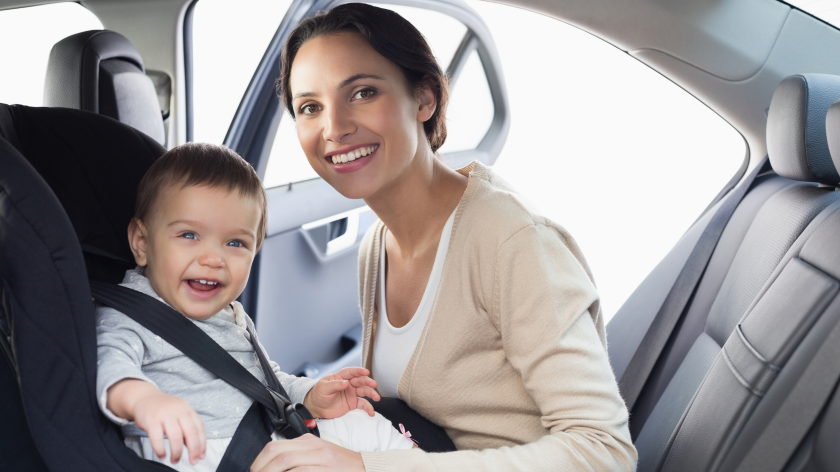Let’s Go, Baby! Car Seat and Travel Tips for Babies

Everyone knows that you need a car seat for your child, from birth until your state mandates that he or she is old enough/large enough to sit in the back seat with a seat belt. But it’s not as simple as running to your local department store, picking out a seat, and strapping it in on the day you bring your baby home.
Like having your nursery and baby supplies set up before you leave for the hospital, you will need to prepare ahead of time because car seats are definitely not a one-size-fits-all item. Infants and toddlers need a rear-facing seat. It’s recommended that until your baby is old enough to hold his or her head up, someone should ride in the backseat with the baby, to make sure his/her head does not drop forward. This includes on your first trip home from the hospital.
Car seat safety and installation are mandated by government safety standards, just like other features related to driving a car. Before you head out to your local retailer to pick up any old car seat, it’s a wise investment to do your homework. These are safety devices that offer added protection for your child, and improper installation or use can result in tragedy.
If you are not sure what to buy, BabyList offers some recommendations for infant models that may appeal to you. Be sure to check the return policy and keep the receipt, in case for any reason your car seat does not pass inspection.
Inspection?
That’s right! Just like you take your car in for a safety inspection, it’s advised to take your car seat in for one, too. Every Wednesday, by appointment, the Miami-Dade Police Department offers free inspections/installations, and will teach you how to properly secure your car seat and your baby. They also offer subsidized car seats for qualifying families (based on availability). (However, they do not offer infant seats at this time.)
Public Transportation, Intercity Buses, and Trains
If you don’t have a car and rely on public transportation, a car seat will not be helpful because it cannot be safely secured. In this case, it’s advised you sit whenever possible and keep your baby strapped to you in a front-harness. If you yourself can use a seat belt on the bus, it’s encouraged that you do. Before traveling by tour/long distance bus or train, speak with the company to ask them about the safest way to travel with your infant on their carrier, as many also cannot accommodate car seats.
Additional Car Seat Safety Tips
- Never use a car seat in the front seat
- Never drive with a car seat on the floor
- Ask your training technician to show you how to secure your child into the seat
- Never place your baby’s seat or carrier on the roof of the vehicle
- Always triple-check that the seat is properly secured
- Avoid used car seats. Seats are manufactured with an expiration date and can also experience UV damage from sunlight, which shows up as white streaks in the plastic.
- If you do select a used car seat, please exercise caution and take it for a complete safety inspection first, to check for damage, missing parts, etc.
- Car seats are only good for one crash – the same way airbags can only be used once. If you experience an accident, you will need to replace your child’s car seat.
- Never leave an infant or child (or pet) unattended in a parked car, even for short periods. Cars become hot inside, even in cooler weather, and it’s extremely dangerous.
Practice Early and Often
Practice installing and uninstalling your car seat a few times. After your initial training, go back to the Police Department training for repeated inspections to make sure you’ve got it down pat on your own.
As your child grows, they will upgrade to a front-facing seat, then to a booster seat, and finally be old enough and large enough to sit in the back seat. Each time you get a new model car seat, go back for training. If your car seat gets cracked or damaged, even slightly, bring it for inspection to make sure that none of its functionality was compromised. Each time you get a new model, take it for installation training and inspections.
Having confidence that you are correctly installing your baby’s car seat each and every time will help bring you that much closer to ensuring your child’s safety.
Please consult with your local state-licensed technician for more information and training.
